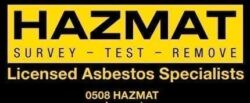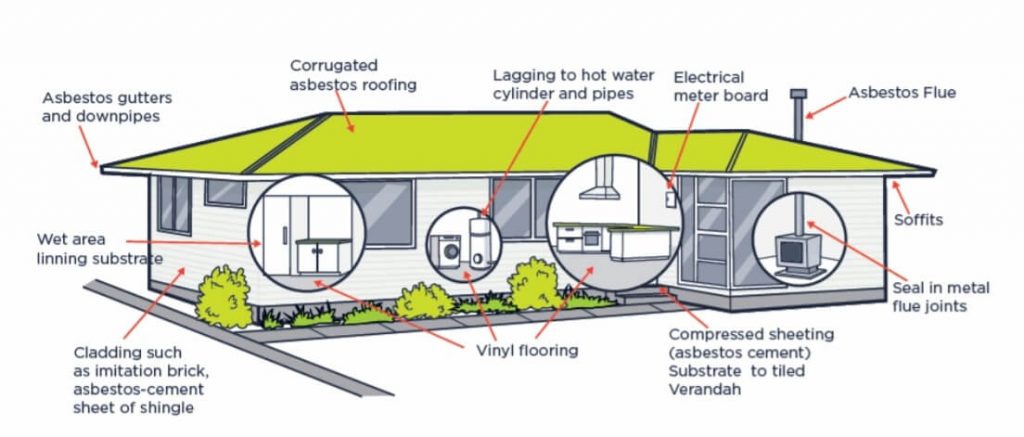If you are doing residential work and you are unsure whether asbestos may be present or not, it always pays to get it tested first. So, where is asbestos likely to be found?
Any building constructed, altered or refurbished before the 1990’s is likely to contain asbestos and/or asbestos containing materials (ACMs). Buildings constructed after 1990 are less likely to contain ACMs but as materials containing asbestos were still permitted to be imported into New Zealand up until August 2016 this still poses significant risks to homeowners, office workers and tradespeople.
Asbestos Containing Material (ACMs) may be found in:
Roofs
corrugated cement roofing, including lap cement dust. (Debris in the roof space from a previous roof replacement may contain asbestos)
guttering, downpipes, rainwater head
Ceilings
ceiling tiles
sprayed/textured ceilings
lathe and plaster (skim coat)
External cladding and eaves
sheet claddings (flat/corrugated)
baseboards and kickboards
shingles
imitation brick/stone claddings
soffit linings
Interior walls and finishes
sprayed/textured wall finishes
insulation board (eg around fireplaces)
plasterboard lining and jointing compound & skim coat on lathe and plaster
Floors
vinyl sheet and tile flooring
Insulation
roof and wall insulation
lagging (insulation)
hot water cylinder insulation
Pipes
drainage pipes
Miscellaneous
flues
seals on wood burners/fire doors
fuse boards (mill board)/linings in fuse holders
fire cement in old chimneys
night store heater
fences
Moss, lichen and algae from the roof and exterior walls
ASBESTOS IN HOMES
Asbestos containing materials come in all shapes, sizes and colours. There are mostly three types of raw asbestos used in NZ-blue, brown and white asbestos, and all were used in many building products.
Asbestos was often mixed with other materials so it is virtually impossible to identify by eye whether or not it is present in suspect materials.
The only way to be certain if your home contains asbestos is to have materials tested in an accredited laboratory. Do not attempt to obtain a sample as you may contaminate your home and family. Be sure to call www.hazmat.co.nz
It is estimated that there could be over 70,000 dwellings in Christchurch alone that have asbestos containing materials present. Asbestos containing materials were a common building product from the 1940’s through until the 1990’s. Because asbestos is fire, heat, chemical and noise resistant as well as providing added strength to otherwise brittle materials (such as cement) it was widely used.
In some instances it was used earlier than 1940, such as in lathe and plaster.
Asbestos can be found in:
asbestos cement products (pipes, flues, roofs etc)
wall cladding (fibrolite)
lagging (on pipes and boilers etc)
water tanks
asbestos insulating board
sprayed coatings on ceilings, walls and beams/columns
textured decorative coatings, flat and stippled plaster
vinyl floor tiles
textiles and composites
gaskets and ropes (such as on wood burners)
lathe and plaster
mastics and sealants
damp proof courses (malthoid)
MANAGING ASBESTOS
You must test every substrate above prior to any renovation.
www.hazmat.co.nz Asbestos Testing Advisors can ensure we sample and test all areas of your home utilising NATA accredited laboratories for complete piece of mind.
If you intend to leave areas some areas undisturbed, and it is in a good stable condition, and it won’t be impacted in any way by the renovation work, then it may be OK to leave it. www.hazmat.co.nz Accredited Asbestos Supervisors are trained in this and can best inform and advise you on a case by case basis during an onsite inspection.
Remember:
Asbestos left undisturbed, in good condition or sealed is relatively safe. If it is easily crumbled, broken down, or damaged or if you intend to drill it, sand it or break it up, can be harmful and needs Hazmat specialist attention.
Residue from asbestos left in your home can cause health issues in the future and there is no guarantees these substrates may not be damaged or cracked in the future from normal household wear and tear e.g. kids playthings/balls, brackets, remodels, repainting, subsidence, earthquakes etc .
There are certain types of work with asbestos containing materials that by law can only be carried out by, or under the direct supervision of, someone who holds a Class A Asbestos Licence.

